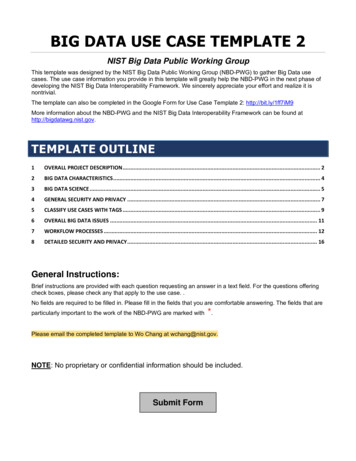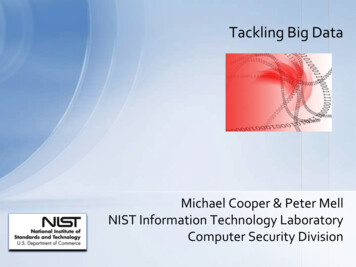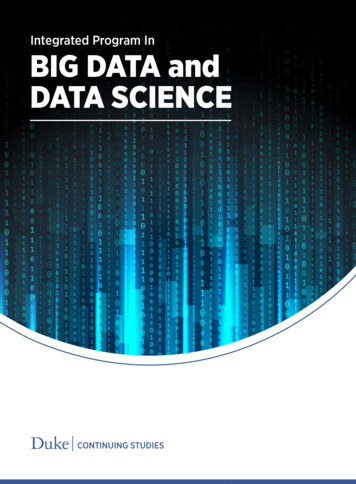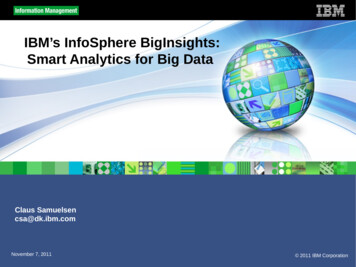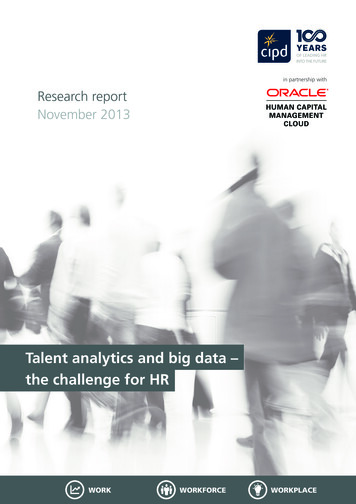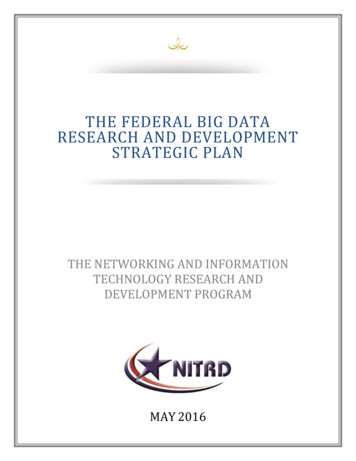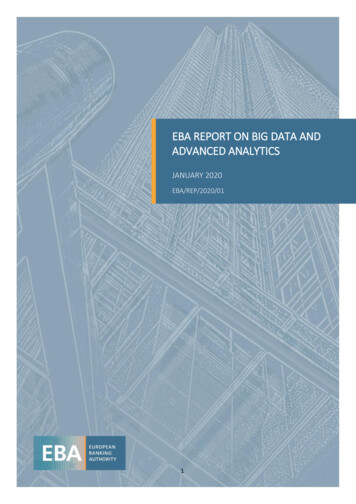
Transcription
EBA REPORT ON BIG DATA ANDADVANCED ANALYTICSJANUARY 2020EBA/REP/2020/011
EBA REPORT ON BIG DATA AND ADVANCED ANALYTICSContentsAbbreviations3Executive summary4Background81.Introduction111.1Key terms121.2Types of advanced analytics141.3Machine-learning modes152.Current landscape162.1Current observations162.2Current application areas of BD&AA193.Key pillars253.1Data management253.2Technological infrastructure273.3Organisation and governance283.4Analytics methodology294.Elements of trust in BD&AA354.1Ethics354.2Explainability and interpretability354.3Fairness and avoidance of bias374.4Traceability and auditability (including versioning)394.5Data protection and quality404.6Security414.7Consumer protection425.Key observations, risks and opportunities435.1Key observations435.2Key opportunities435.3Key risks and proposed guidance446.Conclusions47Annex I49Annex II53Annex III582
EBA REPORT ON BIG DATA AND ADVANCED icial IntelligenceAnti-Money Laundering/Countering the financing of terrorismApplication Programming InterfaceBig Data and Advanced AnalyticsClosed-Circuit televisionEuropean Banking AuthorityEuropean Central BankEuropean Supervisory AuthoritiesEuropean UnionFinancial TechnologyGeneral Data Protection RegulationGlobal Positioning SystemInformation and Communication TechnologyMachine LearningUS National Institute of Standards and TechnologyNatural Language ProcessingRegulatory TechnologySupervisory Technology3
EBA REPORT ON BIG DATA AND ADVANCED ANALYTICSExecutive summaryA data-driven approach is emerging across the banking sector, affecting banks’ business strategies,risks, technology and operations. Corresponding changes in mindset and culture are still inprogress. Following the cross-sectoral report by the Joint Committee of the European SupervisoryAuthorities (ESAs) on the use of big data by financial institutions1, and in the context of the EBAFinTech Roadmap, the EBA decided to pursue a ‘deep dive’ review on the use of big data andAdvanced Analytics (BD&AA) in the banking sector. The aim of this report is to share knowledgeamong stakeholders on the current use of BD&AA by providing useful background on this area,along with key observations, and presenting the key pillars and elements of trust that couldaccompany their use.The report focuses on BD&AA techniques and tools, such as machine learning (ML) (a subset ofArtificial Intelligence (AI)), that go beyond traditional business intelligence to gain deeper insights,make predictions or generate recommendations using various types of data from various sources.ML is certainly one of the most prominent AI technologies at the moment, often used in advancedanalytics due to its ability to deliver enhanced predictive capabilities.BD&AA are driving fundamental change in institutions’ business models and processes. Currently,BD&AA are part of most institutions’ digital transformation programmes, along with the growinguse of cloud services, which is perceived in some instances to facilitate the use of BD&AA. Corebanking data are currently the main flow feeding data analytics, rather than other data sourcessuch as external social media data, due to institutions’ concerns about the reliability and accuracyof external data. A key constraint for institutions is the integration of BD&AA into existing businessprocesses, as they recognise the need to develop relevant knowledge, skills and expertise in thisarea. Institutions appear to be at an early stage of ML use, with a focus on predictive analytics thatrely mostly on simple models; more complex models can bring better accuracy and performancebut give rise to explainability and interpretability issues. Other issues such as accountability, ethicalaspects and data quality need to be addressed to ensure responsible use of BD&AA. At this stage,institutions leverage BD&AA mainly for customer engagement and process optimisation purposes(including RegTech), with a growing interest in the area of risk management.Key pillars of BD&AAThis report identifies four key pillars for the development, implementation and adoption of BD&AA,which interact with each other and are thus not mutually exclusive. These pillars require review byinstitutions to ensure they can support the roll-out of advanced 157971/Joint Committee Final Report on Big Data %28JC-201804 %29.pdf4
EBA REPORT ON BIG DATA AND ADVANCED ANALYTICSThe four pillars are listed below.(i)Data managementData management enables the control and security of data for enterprise purposes taking intoaccount data types and data sources, data protection and data quality. A successful datamanagement approach, which builds trust and meets legal requirements, could lead toimproved decision-making, operational efficiency, understanding of data and regulatorycompliance.(ii)Technological infrastructureTechnological infrastructure entails processing, data platforms and infrastructure that providethe necessary support to process and run BD&AA.(iii)Organisation and governanceAppropriate internal governance structures and organisational measures, along with thedevelopment of sufficient skills and knowledge, support the responsible use of BD&AA acrossinstitutions and ensure robust oversight of their use.(iv)Analytics methodologyA methodology needs to be in place to facilitate the development, implementation andadoption of advanced analytics solutions. The development of an ML project follows a lifecyclewith specific stages (e.g. data preparation, modelling, monitoring) that differs from theapproach adopted for standard business software.The elements of trustThe report finds that the roll-out of BD&AA specifically affects issues around trustworthiness andnotes a number of fundamental trust elements that need to be properly and sufficiently addressedand which cut across the four key pillars. Efforts to ensure that AI/ML solutions built by institutionsrespect these trust elements could have implications for all the key pillars. The trust elements are: Ethics: in line with the Ethics guidelines for trustworthy AI from the European Commission’sHigh-Level Expert Group on AI2, the development, deployment and use of any AI solution shouldadhere to some fundamental ethical principles, which can be embedded from the start in any ews/ethics-guidelines-trustworthy-ai5
EBA REPORT ON BIG DATA AND ADVANCED ANALYTICSproject, in a sort of ‘ethical by design’ approach that can influence considerations aboutgovernance structures. Explainability and interpretability: a model is explainable when its internal behaviour can bedirectly understood by humans (interpretability) or when explanations (justifications) can beprovided for the main factors that led to its output. The significance of explainability is greaterwhenever decisions have a direct impact on customers/humans and depends on the particularcontext and the level of automation involved. Lack of explainability could represent a risk in thecase of models developed by external third parties and then sold as ‘black box’ (opaque)packages.Explainability is just one element of transparency. Transparency consists in making data,features, algorithms and training methods available for external inspection and constitutes abasis for building trustworthy models. Fairness and avoidance of bias: fairness requires that the model ensure the protection of groupsagainst (direct or indirect) discrimination3. Discrimination can be a consequence of bias in thedata, when the data are not representative of the population in question. To ensure fairness,the model should be free from bias. Note, however, that bias can be introduced in many ways.Techniques for preventing or detecting bias exist and continue to evolve (a current researchfield). Traceability and auditability: the use of traceable solutions assists in tracking all the steps,criteria and choices throughout the process, which enables the repetition of the processesresulting in the decisions made by the model and helps to ensure the auditability of the system. Data protection: data should be adequately protected with a trustworthy BD&AA system thatcomplies with current data protection regulation. Data quality: the issue of data quality needs to be taken into account throughout the BD&AAlifecycle, as considering its fundamental elements can help to gain trust in the data processed. Security: new technology trends also bring new attack techniques exploiting securityvulnerabilities. It is important to maintain a technical watch on the latest security attacks andrelated defence techniques and ensure that governance, oversight and the technicalinfrastructure are in place for effective ICT risk management. Consumer protection: a trustworthy BD&AA system should respect consumers’ rights andprotect their interests. Consumers are entitled to file a complaint and receive a response in plainlanguage that can be clearly understood4. Explainability is key to addressing this obligation.3Discrimination (intentional or unintentional) occurs when a group of people (with particular shared characteristics) ismore adversely affected by a decision (e.g. an output of an AI/ML model) than another group, in an inappropriate JC 2014 43 - Joint Committee - Final report complaintshandling 56
EBA REPORT ON BIG DATA AND ADVANCED ANALYTICSFigure 0.1: Key pillars and elements of trust in BD&AAIt was observed that, within institutions, the specific implementation of the key pillars may changeover time. For example, from a regulatory perspective, the EBA’s Guidelines on internalgovernance5, on outsourcing arrangements6 and on ICT and security risk management7 set thebaseline for a sound internal governance and resilient risk management framework. Nevertheless,technological infrastructure remains an ongoing challenge for most institutions as they deal withrelated legacy issues. In addition, the use of new, often diverse, sources of data and increasedrecognition of citizens’ rights over that data creates specific challenges for data management insideinstitutions, which require attention and possibly targeted action.Moreover, the need to build the trust elements into the development of advanced analyticsapplications, for example to ensure the explainability and ethical design of such solutions, willrequire ongoing work.Going forward, the EBA will continue to observe (taking into account also other work being doneby the ESAs and work being done in other international fora) and consider the pace of evolution ofBD&AA in financial services (in line with its FinTech Roadmap), and, where appropriate, it willaccompany this work with opinions and/or proposals for guidelines to achieve a coordinatedapproach to the regulatory and supervisory treatment of AI and BD&AA t7
EBA REPORT ON BIG DATA AND ADVANCED ANALYTICSBackgroundArticle 1(5) of the Regulation establishing the EBA (Regulation (EU) No 1093/2010) requires the EBAto contribute to promoting a sound, effective and consistent level of regulation and supervision,ensuring the integrity, transparency, efficiency and orderly functioning of financial markets,preventing regulatory arbitrage and promoting equal competition. In addition, Article 9(2) requiresthe EBA to monitor new and existing financial activities.These mandates are key motivations underpinning the EBA’s interest in financial innovation ingeneral and more specifically in FinTech. The EBA decided to take forward work in relation toFinTech by publishing its FinTech Roadmap setting out its priorities for 2018/2019. One of thepriorities set out in the EBA FinTech Roadmap is the analysis of the prudential risks andopportunities for institutions arising from FinTech, including with regard to the development andsharing of knowledge among regulators and supervisors. This thematic report, a step towards thispriority, follows the EBA’s Report on the prudential risks and opportunities for institutions arisingfrom FinTech8 as well as the ESAs’ Joint Committee final report on big data9.In the context of its ongoing monitoring, the EBA has observed a growing interest in the use of BigData Analytics (as noted in the EBA risk assessment questionnaires); institutions see potential inthe use of advanced analytics techniques, such as ML, on very large, diverse datasets from differentsources and of different sizes. Figure 0.2 shows that institutions are using BD&AA to a significantextent in their operations, with 64% of institutions reporting having already launched BD&AAsolutions, while within 1 year around 5% of institutions moved from a pilot testing and/ordevelopment phase to deployment. In general, almost all institutions are exploring the use ofBD&AA.Figure 0.2: Use of Big Data Analytics across EU institutions60% 64%11%In use / launched19% 17%8%6%Pilot testingUnder developmentY201811%Under discussion2%2%No activityY2019Source: EBA risk assessment questionnaires (autumn 2018 and autumn 9/Report on prudential risks and opportunities arising for institutions from lt/files/library/jc-2018-04 joint committee final report on big data.pdf8
EBA REPORT ON BIG DATA AND ADVANCED ANALYTICSThis report provides background information on BD&AA, along with an educational perspective,and describes the current landscape as regards their use in the banking sector, without making
banking data are currently the main flow feeding data analytics, rather than other data sources such as external social media data, due to institutions [ concerns about the reliability and accuracy of external data. A key constraint for institutions is the integration of BD&AA into existing business processes, as they recognise the need to develop relevant knowledge, skills and expertise in .
